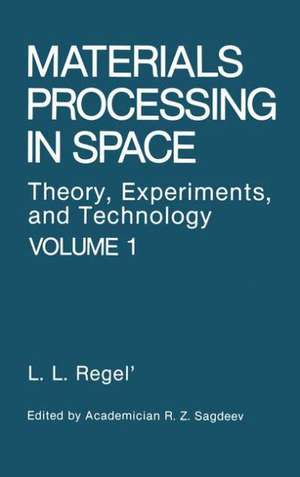Materials Processing in Space: Theory, Experiments, and Technology
Autor Liya L. Regel Editat de R. Z. Sagdeev Traducere de J.E.S. Bradleyen Limba Engleză Paperback – 22 feb 2012
Preț: 388.90 lei
Nou
Puncte Express: 583
Preț estimativ în valută:
74.42€ • 81.16$ • 62.75£
74.42€ • 81.16$ • 62.75£
Carte tipărită la comandă
Livrare economică 24 aprilie-08 mai
Preluare comenzi: 021 569.72.76
Specificații
ISBN-13: 9781468416855
ISBN-10: 1468416855
Pagini: 248
Ilustrații: 248 p.
Dimensiuni: 178 x 254 x 13 mm
Greutate: 0.44 kg
Ediția:Softcover reprint of the original 1st ed. 1990
Editura: Springer Us
Colecția Springer
Locul publicării:New York, NY, United States
ISBN-10: 1468416855
Pagini: 248
Ilustrații: 248 p.
Dimensiuni: 178 x 254 x 13 mm
Greutate: 0.44 kg
Ediția:Softcover reprint of the original 1st ed. 1990
Editura: Springer Us
Colecția Springer
Locul publicării:New York, NY, United States
Public țintă
ResearchCuprins
1. Theory of Liquid Behavior and Crystal Growth under Reduced Gravity.- 1.1. Fluid Mechanics and Heat and Mass Transfer in Microgravity.- 1.2 Effects of Gravitational Convection on Crystal Growth in Microgravity.- 1.3. Thermocapillary and Capillary-Concentration Convection (Marangoni Convection).- 1.4. External-Force Control of Liquid-Surface Stability.- 1.5. Laboratory Simulation of Microgravity Processes.- 1.6. Theory of Impurity Distribution, Segregation, and Stratification.- 1.7. Nucleation Theory and Gas-Bubble Motion in Microgravity: Liquid Boiling.- 1.8. The Physics of Liquids, Liquid Bridges under Microgravity, Floating Zones in Zone Melting, and Liquid Free-Surface Shapes.- 1.9. Capillary Forces and Liquid Shaping in Microgravity, Including Contact Phenomena at Liquid-Tube Boundaries.- 1.10. Gravitational Conditions on Space Vehicles and the Destabilizing Effects of Residual Acceleration on Solidification and Thermal Oscillations.- 1.11. Conclusions.- 2. Semiconductor Growth from Melts and Vapors under Microgravity.- 2.1. Microgravity Growth of Ge and Si Crystals from Melts.- 2.2. Microgravity Growth of AIIIBV Semiconductor Compound Crystals.- 2.3. Microgravity Growth of AIIBVI, AIVBVI, and Other Semiconductor Solid Solutions.- 2.4. Microgravity Growth of Semiconductor Crystals from the Vapor State.- 2.5. Conclusions.- 3. Microgravity Solidification of Metals, Eutectics, and Composites.- 3.1. Immiscible-Alloy Separation.- 3.2. Metal-Matrix Composite Melting and Crystallization.- 3.3. Foam Metal Production.- 3.4. Eutectic Crystallization.- 3.5. Superconductor, Intermetallide, and Magnetic-Material Crystallization.- 3.6. Dendritic and Cellular Crystallization.- 3.7. Capillary and Surface Forces at Contacts with Solids under Microgravity.- 3.8. Diffusion, ThermalDiffusion, and Electrical Transport.- 3.9. Welding, Soldering, and Cutting.- 3.10. Conclusions.- 4. Microgravity Solidification of Glass.- 4.1. Nucleation, Metal-Glass Formation, and Supercooled-Alloy Solidification.- 4.2. Gas-Bubble Formation Kinetics in Glass Solidification.- 4.3. Reaction Kinetics in Molten Alkali Glasses and Component Diffusion.- 4.4. Conclusions.- 5. Microgravity Growth of Crystals from Aqueous Solution.- 5.1. Growth of Metallic-Conduction Organic Crystals.- 5.2. Growth of Sparingly Soluble Crystals.- 5.3. Protein Crystal Growth.- 5.4. Conclusions.- 6. Apparatus and Methods for Microgravity and Materials Science in Space.- 6.1. Microgravity High-Temperature Heaters.- 6.2. Apparatus for Fluid Physics and Solution Crystallization.- 6.3. Cutting, Welding, and Coating Apparatus.- 6.4. Levitation under Microgravity.- 6.5. Space Holographic Equipment (SHE).- 6.6. Microaccelerometers and Research on Gravitation in Space Vehicles.- 6.7. Conclusions.- 7. Experiments on Short-Term Weightlessness: Towers, Aircraft, and Rockets.- 7.1. Experiments on Aircraft, Towers, and Balloons.- 7.2. Mir Rocket Experiments in the USSR.- 7.3. Some Texus-Program Rocket Experiments.- 7.4. Apparatus for Engineering Experiments on Rockets.- 7.5. Conclusions.- 8. Crystal Growth and Alloy Solidification under Elevated Gravity.- 8.1. Centrifuge Methods of Studying Semiconductor Crystal Growth and Liquid Solidification.- 8.2. Production of Silver-Doped Lead Telluride Crystals under Elevated Gravity.- 8.3. Solidification of Tellurium-Silicon Glass and the Crystallization of Tellurium and Tellurium-Selenium Alloys under Elevated Gravity.- 8.4. Solidification of Al-Cu Eutectic Alloy under Elevated Gravity.- 8.5. Prospects for Studying Crystal Growth and Metal Solidification under Elevated Gravity.- 9. Microgravity Electrophoresis.- 9.1. General Electrophoresis Data.- 9.2. Theory of Microgravity Electrophoresis.- 9.3. Microgravity Electrophoresis Apparatus.- 9.4. Results on Microgravity Electrophoresis.- 9.5. Conclusions: Prospects for Microgravity Electrophoresis Applied to Purifying and Separating Biologically Active Compounds.- 10. Research in Materials Science in Space.- 10.1. Aspects of Microgravity Physics and Materials Science in Space.- 10.2. Research Results and Survey Publications.- 10.3. Forecasts, Programs, and Research Prospects in Materials Science in Space.- 10.4. Conclusions.- References.








